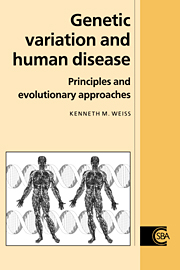Book contents
- Frontmatter
- Contents
- Frontispiece
- Preface: what is this book all about?
- Notational conventions used in this book
- List of abbreviations
- Part I Genes and their expression
- Part II Introduction to genetic epidemiology: inference from observational data
- Part III Evolution: the time dimension in populations
- 9 Genes over time and space
- 10 Reconstructing history: the footprints of evolution
- 11 Evolution generates heterogeneity
- Part IV Modification of the inherited genotype: the time dimension in individuals
- Afterwords: towards a unified general model
- References
- Index
11 - Evolution generates heterogeneity
from Part III - Evolution: the time dimension in populations
Published online by Cambridge University Press: 05 June 2012
- Frontmatter
- Contents
- Frontispiece
- Preface: what is this book all about?
- Notational conventions used in this book
- List of abbreviations
- Part I Genes and their expression
- Part II Introduction to genetic epidemiology: inference from observational data
- Part III Evolution: the time dimension in populations
- 9 Genes over time and space
- 10 Reconstructing history: the footprints of evolution
- 11 Evolution generates heterogeneity
- Part IV Modification of the inherited genotype: the time dimension in individuals
- Afterwords: towards a unified general model
- References
- Index
Summary
All healthy families resemble each other. Each unhealthy family is unhealthy in its own way.
With apologies to Leo Tolstoy, Anna Karenina (1877)The ‘Rusty Rule’
The previous chapter focused on the evolutionary determinants of the frequency of disease-related alleles, and the trail and structure left by the unique history of mutations in each population. Evolution systematically generates variation, but is the amount of variation so great as to change our traditional notions that there is ‘a’ locus, or ‘a’ mutation that is responsible for ‘a’ disease in the majority of cases?
This chapter uses examples to characterize the level of heterogeneity that led me to introduce (Chapter 2) the ‘Rusty Rule’ that whatever can go wrong will go wrong – in some family, at some time. In fact, the amount of heterogeneity associated with most traits can lead to great difficulty in applying the segregation and linkage methods of Part II, a problem we are just beginning to face.
Etiological and phenotypic heterogeneity for qualitative traits
A number of the classic genetic diseases have now been studied at the DNA level. In each case, a similar story is told, one that is consistent with evolutionary genetics. It is the story of many different alleles, or even loci, associated with the same phenotype, or of what seemed originally to be a unitary phenotype decomposing before our eyes as subtle phenotypic differences associated with identifiable allelic differences are discovered.
- Type
- Chapter
- Information
- Genetic Variation and Human DiseasePrinciples and Evolutionary Approaches, pp. 205 - 226Publisher: Cambridge University PressPrint publication year: 1993



